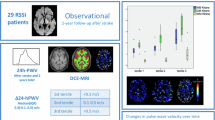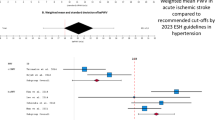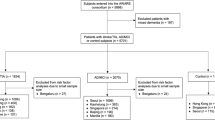Abstract
The presence of cerebral white matter lesions (WMLs) on MRI is suggested to be a predictive factor for vascular dementia and stroke. To investigate the relationship between arterial stiffness and WMLs, we performed brain MRI to evaluate the presence of two subtypes of WML—periventricular hyperintensities (PVH) and deep white matter lesions (DWML)—and furthermore, determined the brachial-ankle pulse wave velocity (ba-PWV) as a marker of arterial stiffness in 132 elderly asymptomatic subjects (49 men and 83 women, 70.3±9.0 years). PVH and DWML were observed in 41 (31.0%) and 53 (40.2%) subjects, respectively. The ba-PWV values were significantly greater in subjects with PVH than in those without. DWML also tended to be associated with ba-PWV, but the correlation was not statistically significant. In multiple logistic regression analysis, age and decreased DBP were independently associated with PVH. ba-PWV was also detected as an independent factor for the appearance of PVH (adjusted odds ratio: 2.84, p=0.015) but not DWML. These results indicate that the increase in arterial stiffness contributes to the pathogenesis of PVH rather than DWML. Although further study is needed to clarify the difference between WML subtypes, our study suggests that the measurement of ba-PWV is a simple and useful tool for detecting cerebral arterial dysfunction. (Hypertens Res 2008; 31: 75−81)
Similar content being viewed by others
Article PDF
References
de Leeuw FE, de Groot JC, Athten E, et al : Prevalence of cerebral white matter lesions in elderly people: a population based magnetic resonance imaging study. The Rotterdam Scan Study. J Neurol Neurosurg Psychiatry 2001; 70: 9–14.
Ylikoski A, Erkinjuntti T, Raininko R, Sarna S, Sulkava R, Tilvis R : White matter hyperintensities on MRI in the neurologically nondiseased elderly. Analysis of cohorts of consecutive subjects aged 55 to 85 years living at home. Stroke 1995; 26: 1171–1177.
Fukuda H, Kobayashi S, Okada K, Tsunematsu T : Frontal white matter lesions and dementia in lacunar infarction. Stroke 1990; 21: 1143–1149.
Breteler MM, van Amerongen NM, van Swieten JC, et al : Cognitive correlates of ventricular enlargement and cerebral white matter lesions on magnetic resonance imaging. The Rotterdam Study. Stroke 1994; 25: 1109–1115.
Greenwald BS, Kramer-Ginsberg E, Krishnan KR, Ashtari M, Auerbach C, Patel M : Neuroanatomic localization of magnetic resonance imaging signal hyperintensities in geriatric depression. Stroke 1998; 29: 613–617.
Baloh RW, Yue Q, Socotch TM, Jacobson KM : White matter lesions and disequilibrium in older people. I. Case-control comparison. Arch Neurol 1995; 52: 970–974.
Braffman BH, Zimmerman RA, Trojanowski JQ, Gonatas NK, Hickey WF, Schlaepfer WW : Brain MR: pathologic correlation with gross and histopathology. 2. Hyperintense white-matter foci in the elderly. AJR Am J Roentgenol 1988; 151: 559–566.
Schmidt R, Fazekas F, Kapeller P, Schmidt H, Hartung HP : MRI white matter hyperintensities: three-year follow-up of the Austrian Stroke Prevention Study. Neurology 1999; 53: 132–139.
de Leeuw FE, de Groot JC, Oudkerk M, et al : Hypertension and cerebral white matter lesions in a prospective cohort study. Brain 2002; 125: 767–772.
Vermeer SE, Hollander M, van Dijk EJ, Hofman A, Koudstaal PJ, Breteler MM : Silent brain infarcts and white matter lesions increase stroke risk in the general population: the Rotterdam Scan Study. Stroke 2003; 34: 1126–1129.
Barber R, Scheltens P, Gholkar A, et al : White matter lesions on magnetic resonance imaging in dementia with Lewy bodies, Alzheimer's disease, vascular dementia, and normal aging. J Neurol Neurosurg Psychiatry 1999; 67: 66–72.
Yao H, Sadoshima S, Kuwabara Y, Ichiya Y, Fujishima M : Cerebral blood flow and oxygen metabolism in patients with vascular dementia of the Binswanger type. Stroke 1990; 21: 1694–1699.
Fazekas F, Kleinert R, Offenbacher H, et al : Pathologic correlates of incidental MRI white matter signal hyperintensities. Neurology 1993; 43: 1683–1689.
Leifer D, Buonanno FS, Richardson EP Jr : Clinicopathologic correlations of cranial magnetic resonance imaging of periventricular white matter. Neurology 1990; 40: 911–918.
Mourad JJ, Pannier B, Blacher J, et al : Creatinin clearance, pulse wave velocity, carotid compliance and essential hypertension. Kidney Int 2001; 59: 1834–1841.
Suzuki E, Kashiwagi A, Nishio Y, et al : Increased arterial wall stiffness limits in the lower extrimities in type 2 diabetic patient. Diabetes Care 2001; 24: 2107–2114.
Laurent S, Boutouyrie P, Asmar R, et al : Aortic stiffness is an independent predictor of all-cause and cardiovascular mortality in hypertensive, patients. Hypertension 2001; 37: 1236–1241.
Lehmann ED, Hopkins KD, Jones RL, Rudd AG, Gosling RG : Aortic distensibility in patients with cerebrovascular disease. Clin Sci (Lond) 1995; 89: 247–253.
Laurent S, Katsahian S, Fassot C, et al : Aortic stiffness is an independent predictor of fatal stroke in essential hypertension. Stroke 2003; 34: 1203–1206.
Takashima Y, Yao H, Koga H, et al : Frontal lobe dysfunction caused by multiple lacunar infarction in community-dwelling elderly subjects. J Neurol Sci 2003; 214: 37–41.
Fazekas F, Chawluk JB, Alavi A, Hurtig HI, Zimmerman RA : MR signal abnormalities at 1.5 T in Alzheimer's dementia and normal aging. AJR Am J Roentgenol 1987; 149: 351–356.
Nakamura U, Iwase M, Nohara S, Kanai H, Ichikawa K, Iida M : Usefulness of brachial-ankle pulse wave velocity measurement: correlation with abdominal aortic calcification. Hypertens Res 2003; 26: 163–167.
Yamashina A, Tomiyama H, Takeda K, et al : Validity, reproducibility, and clinical significance of noninvasive brachial-ankle pulse wave velocity measurement. Hypertens Res 2002; 25: 359–364.
Ogawa O, Onuma T, Kubo S, Mitsuhashi N, Muramatsu C, Kawamori R : Brachial-ankle pulse wave velocity and symptomatic cerebral infarction in patients with type 2 diabetes: a cross-sectional study. Cardiovasc Diabetol 2003; 2: 10.
Yufu K, Takahashi N, Anan F, Hara M, Yoshimatsu H, Saikawa T : Brachial arterial stiffness predicts coronary atherosclerosis in patients at risk for cardiovascular diseases. Jpn Heart J 2004; 45: 231–242.
Yamauchi H, Fukuda H, Oyanagi C : Significance of white matter high intensity lesions as a predictor of stroke from arteriolosclerosis. J Neurol Neurosurg Psychiatry 2002; 72: 576–582.
de Leeuw FE, de Groot JC, Oudkerk M, et al : Aortic atherosclerosis at middle age predicts cerebral white matter lesions in the elderly. Stroke 2000; 31: 425–429.
Miwa Y, Tsushima M, Arima H, Kawano Y, Sasaguri T : Pulse pressure is an independent predictor for the progression of aortic wall calcification in patients with controlled hyperlipidemia. Hypertension 2004; 43: 536–540.
Shimada K, Kawamoto A, Matsubayashi K, Ozawa T : Silent cerebrovascular disease in the elderly. Correlation with ambulatory pressure. Hypertension 1990; 16: 692–699.
O'Sullivan C, Duggan J, Lyons S, Thornton J, Lee M, O'Brien E : Hypertensive target-organ damage in the very elderly. Hypertension 2003; 42: 130–135.
Franklin SS, Larson MG, Khan SA, et al : Does the relation of blood pressure to coronary heart disease risk change with aging? The Framingham Heart Study. Circulation 2001; 103: 1245–1249.
Wang J-G, Staessen JA, Gong L, Liu L, Systolic Hypertension in China (Syst-China) Collaborative Group : Chinese trial on isolated systolic hypertension in the elderly. Arch Intern Med 2000; 160: 211–220.
Author information
Authors and Affiliations
Corresponding author
Rights and permissions
About this article
Cite this article
Ohmine, T., Miwa, Y., Yao, H. et al. Association between Arterial Stiffness and Cerebral White Matter Lesions in Community-Dwelling Elderly Subjects. Hypertens Res 31, 75–81 (2008). https://doi.org/10.1291/hypres.31.75
Received:
Accepted:
Issue Date:
DOI: https://doi.org/10.1291/hypres.31.75
Keywords
This article is cited by
-
Cerebral microcirculatory pulse wave propagation and pulse wave amplitude mapping in retrospectively gated MRI
Scientific Reports (2023)
-
Association of brain white matter lesions with arterial stiffness assessed by cardio-ankle vascular index. The Beijing Vascular Disease Evaluation STudy (BEST)
Brain Imaging and Behavior (2021)
-
Effects of interval walking training compared to normal walking training on cognitive function and arterial function in older adults: a randomized controlled trial
Aging Clinical and Experimental Research (2019)
-
Comparison of arteriosclerotic indicators in patients with ischemic stroke: ankle–brachial index, brachial–ankle pulse wave velocity and cardio–ankle vascular index
Hypertension Research (2015)
-
Preventing Vascular Effects on Brain Injury and Cognition Late in Life: Knowns and Unknowns
Neuropsychology Review (2014)



